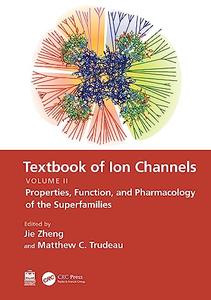
Free Download Textbook of Ion Channels Volume II: Properties, Function, and Pharmacology of the Superfamilies
by Edited by Jie Zheng and Matthew C. Trudeau
English | 2023 | ISBN: 1000857743 | 489 pages | True PDF | 228.08 MB
TheTextbook of Ion Channelsis a set of three volumes that provides a wide-ranging reference source on ion channels for students, instructors, and researchers. Ion channels are membrane proteins that control the electrical properties of neurons and cardiac cells, mediate the detection and response to sensory stimuli like light, sound, odor, and taste, and regulate the response to physical stimuli like temperature and pressure. In non-excitable tissues, ion channels are instrumental for the regulation of basic salt balance that is critical for homeostasis. Ion channels are located at the surface membrane of cells, giving them the unique ability to communicate with the environment, as well as the membrane of intracellular organelles, allowing them to regulate internal homeostasis. Ion channels are fundamentally important for human health and diseases, and are important targets for pharmaceuticals in mental illness, heart disease, anesthesia, pain and other clinical applications. The modern methods used in their study are powerful and diverse, ranging from single ion-channel measurement techniques to models of ion channel diseases in animals, and human clinical trials for ion channel drugs.
Volume II starts with ion channel taxonomy and features coverage of major ion channel families and describes the physiological role, structural components, gating mechanisms and biophysics, permeation and selectivity, regulation, pharmacology and roles in disease mechanisms. Channels in this volume include voltage-activated sodium, calcium and potassium channels, inward-rectifier and two-pore domain potassium channels, calcium-activated potassium channels, cyclic-nucleotide gated channels, pacemaker ion channels, chloride channels, the ligand-gated receptors activated by acetylcholine, glutamate, 5-HT3, GABA and glycine, acid-sensing channels, P2X receptors, TRP channels, store-operated channels, pressure-activated piezo channels, ryanodine receptors and proton channels.
All three volumes give the reader an introduction to fundamental concepts needed to understand the mechanism of ion channels, a guide to the technical aspects of ion channel research, offer a modern guide to the properties of major ion channel families, and include coverage of key examples of regulatory, physiological, and disease roles for ion channels.
